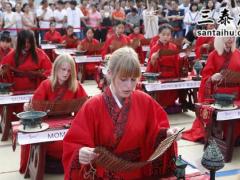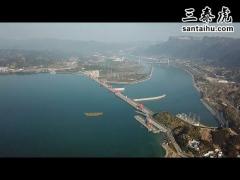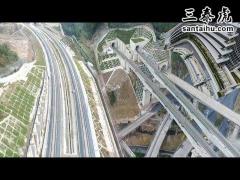【 Quora 】:历史上最伟大的文明是哪个?(上) [美国媒体]
quora网友:很明显的一个…古罗马。它们是地球上最强大的文明之一,大约有1000年的历史。罗马有三个主要阶段:王国、共和国和帝国。罗马王国成立于公元前753年,于公元前509年结束。共和国成立于公元前509年,于公元前27年解体。帝国成立于公元前27年,公元476年衰落结束......
What is the greatest civilization in history?
【 Quora 】:历史上最伟大的文明是哪个?(上)
The obvious one… Ancient Rome.
They were one of Earth’s most powerful civilizations for roughly 1,000 years.
There was three main stages of Rome… the Kingdom, the Republic, and the Empire.
The Roman Kingdom was founded in 753 BC and ended in 509 BC.
The Republic was founded in 509 BC and dissolved in 27 BC.
The Empire was founded in 27 BC and fell in 476 AD.
From around 753 BC to 476 AD, Ancient Rome lasted around 1,229 years!
This makes Rome one of the longest lasting civilizations in history.
I mention that Rome is one of the most influential civilizations in history. Modern day governments like the US get their form of government from the Roman Republic.
Rome’s roadways were some of the most advanced and extensive in all of human history up until the point of the Industrial Revolution. As the famous saying goes “All Roads Lead to Rome.”
Rome is often considered the most advanced civilization up until the point of the Industrial Revolution. That means even a thousand years after Rome’s fall it was more advanced than any civilization on Earth at the time.
Roman architecture is also some of the most advanced in ancient times. The Colosseum is often praised as an architectural wonder but another often overlooked by people is the Pantheon. To this day the Pantheon remains the world’s largest unreinforced concrete dome. The Circus Maximus is also another example of Rome’s engineering skills.
Rome is also know for powerful and successful emperors like Augustus, Trajan, Hadrian, Antoninus Pius, Marcus Aurelius, etc. These men led Rome to conquer land and make it vast and more influential.
Other than emperors, Rome was know for many intellectuals such as Cicero, Seneca the Younger, Livy, Epictetus, Ovid, Virgil, Horace, Plutarch, Seneca the Elder, etc.
Romans were also know for their extensive Aqueducts, concrete, bath houses, temples, libraries, statues, etc.
I could go on longer but I think you get the idea. Rome was a great civilization and arguably the greatest.
很明显的一个…古罗马。
它们是地球上最强大的文明之一,大约有1000年的历史。
罗马有三个主要阶段:王国、共和国和帝国。
罗马王国成立于公元前753年,于公元前509年结束。
共和国成立于公元前509年,于公元前27年解体。
帝国成立于公元前27年,公元476年衰落结束。
从公元前753年到公元476年,古罗马持续了大约1229年。
这使罗马成为历史上最持久的文明之一。
我曾就提到过罗马是历史上最具影响力的文明之一。现在,像美国这样的政府都是从罗马共和国那里得到了他们的政府形式。
在工业革命之前,罗马的道路是人类历史上最先进、最多的道路。正如着名的谚语所说:“条条大道通罗马。”
在工业革命之前,罗马通常被认为是最先进的文明。这意味着,在罗马灭亡后的一千年里,它比地球上的任何文明都要先进。
罗马建筑也是古代最先进的建筑之一。古罗马斗兽场常被誉为建筑奇迹,但人们常常忽视的另一个地方是万神殿。直到今天,万神殿仍然是世界上最大的非钢筋混凝土圆顶。马克西穆斯竞技场也是罗马卓越工程的另一个例子。
罗马知名于像屋大维、图拉真、哈德良、安东尼庇护、马可·奥勒留等强大而成功的皇帝,这些人带领罗马征服土地,并使之变得更大更有影响力。
除了皇帝之外,罗马也有很多知识分子,如西塞罗、塞内卡、李维、爱比克泰德、奥维德、维吉尔、贺拉斯、普鲁塔克、塞内卡等。
罗马人也知名于他们有大量的水渠、混凝土、浴场、庙宇、图书馆、雕像等。
我可以继续讲下去,但我想你已经明白了。罗马是一个伟大的文明,可以说是最伟大的。
------------------------------------------
During the age of the Mauryan Empire, India was was no doubt one of the greatest civilizations on Earth. Much of it’s intellectual and scientific achievements continue into modern India and globally. Founded in 322 B.C. by Chandragupta Maurya, with the wise council of the world’s first political Scientist Prime Minister Chanakya. The Mauryan dynasty was quick in it’s pace to dominate the Indian landscape. Chanakya authored the Arathshasthra, and this contained the world’s first volume on the art of just rule. Following these principles, Chandragupta quickly ousted the Nanda Dynasty, which had made deals with invading Greeks, and westward expansion began. Taking full advantage of the weakness of the Greek Satraps Alexander the Great had left behind, all of India was liberated from this foreign presence. And, in a surprise battle Chandragupta, defeated the Greek General Seluescus, and gained all territories west of the Indus River.Thus, a new philosophy was adopted, and territories coming into the Mauryan Empire were integrated with entirely new policies. There was no pillaging or looting. Instead trade was encouraged, and new religious and social concepts of equity and unity were being spread. This would all culminate and reach a level of development never seen anywhere in the world under, Chandragupta's grandson Ashoka.
The Mauryan Dynasty would reach it’s geographical and cultural zenith under Emperor Pyadaasi Ashoka. For many ages people in India believed him to be a myth as it seemed impossible that such a ruler could have existed in reality. But, in the 1800’s it was proven by archaeological studies, and that he was even more than the even Indian Buddhist records indicated. As Ashoka united the entire Indian Sub-Continent under one rule, he had a profound moral awaking. Ashoka, had reoccurring dreams of the Campaign he waged in Kalinga, which had been one the bloodiest campaigns in his drive for unification. It is said there were over 100,000 causalities. Thus, by many accounts he entered a deep state of depression. When he emerged from this he had converted to the new Indian Religion of Buddhism. And, for the rest of his life he attempted to create a system of humanity for his subjects which even today remains a feat unmatched by modern governments.
During this period in India inventions took place which laid down the basic principles by which mathematics would be governed in the coming ages. The Indian decimal system was invented and replaced all other numbering systems. Many mistakenly call these Arabic Numerals, but in reality they simply introduced these to Europe 1200 years later and played no part in creating this system. The concept of Zero was invented in India used as a place holder. Indian medicine took off in ways not seen again until modern times. Plastic Surgery, standardized herbal medicines to treat illness, and surgical tools were developed. In addition to this, vaccinations were performed. Nearly 2000 years before the West would even conceive of such ideas.
Emperor Ashoka, instituted social reforms to level out economic wealth, he created a system of punishment which was merciful and in which all accused had the right to appeal their sentences directly to the Emperor. He prohibited all acts of torture and mistreatment of prisoners, acts of violence were discouraged, and he gave animals basic rights as well. The world’s first ecological laws were implemented, and needless destruction of forests was forbidden. He created protected species immune from hunting as they were deemed proper for the health of the forests. Ashoka, then went further and created State Sponsored, Medical Research facilities and free health care for all his subjects. Roads were built through out India and Western Asia, with four types of fruit bearing trees so that travelers would have food sources while they traveled in any season. A system of standardized currency and weights and measures were introduced. During his rule, India was the largest economy in the world by far and he had nearly 90 million people under his rule. In 250 B.C. this was more than 1/3 of the world’s population. In terms of scale Ashoka’s India was 1.9 million square miles, and was larger than modern India. He had a standing army of 650,000 men in arms. This was the Ancient world’s largest fighting force. And yet, he voluntarily stopped expanding his Empire. Something never seen in the ancient world. During his 50 years of rule unprecedented achievement occurred in Religion, art, sciences and expression. In Emperor Ashoka’s court open religious debate took place something not seen again until Emperor Akbar’s court in India nearly 2000 years later. Emperor Ashoka even defined the rules of civilized debate as consisting of “ arguing the subject and not against the person.” Most of the symbols and underlying architectural styles used to signify India, in later Empires and even Modern India came about under the Mauryan Dynasty, and especially under Emperor Ashoka. The Indian Stupa style was spread and today is so integral to Chinese,Korean and Japanese design that it is mostly forgotten that this also originated in India, along with Karate and it’s sister Yoga. Indian astrology which was far superior to anything in the world, including the computation of a solar year, gravity and the correct meaning of solar eclipses were documented in this age. During the last 20 years of his life, Ashoka began the process of spreading Indian Culture, Science, and Indian Buddhism.
His ambassadors circled the known world, reaching Greece,China,Japan,Indonesia and Sri Lanka. Much of the world today calls Asian values are actually Indian Values from the time of the Mauryan Empire.He placed pillars all through out India’s borders, and inscribed them with words which stated that the Indian Empire was no threat beyond it’s borders and to trade openly. Emperor Ashoka forbade all forms of torture and capital punishment. And, he discouraged the eating of animals. Thus, Emperor Ashoka was ecologist and humanitarian before much of the world had the vocabulary to describe his vision and edicts. At this point in history India was truly the greatest civilization on Earth. It was his message, which inspired an India ravaged by colonialism and utter poverty to again begin the path to rebuild itself. Through out the course of Indian history, the message of Emperor Ashoka has shown like a guiding star. That an Empire of Spirit, can give birth to an Empire of magnanimity and justice, that so many Empires came and left but the Empire Ashoka created always is present in the hearts and minds of Indians, but also of all those who seek inspiration and renewal. In 1947, the emblem of Emperor Ashoka once more became the Emblem of India. And a unified secular Republic took birth.
在孔雀帝国时代,印度无疑是世界上最伟大的文明之一。它的大部分知识和科学成都继续在现代印度和全球内使用。该帝国在公元前322年由旃陀罗笈多创立,以及世界上第一个政治科学意义上的总理考底利耶。孔雀帝国迅速统治了印度的版图。考底利耶创作了《政事论》,这是世界上第一部关于如何统治的作品。遵循书中原则,旃陀罗笈多很快推翻了抵御希腊入侵和向西扩张的难陀王朝。在充分利用希腊总督亚历山大大帝的弱点后,使得所有的印度人都从外国手中解放出来。在一次意外的战斗中,他打败了希腊将军Seluescus,并占领了印度河西部的所有领土。然后,采用了一种新的哲学,孔雀帝国的领土都与这些全新的哲学政策相结合。没有掠夺,相反,贸易受到了鼓励,新的宗教和社会平等团结的概念正在传播。旃陀罗笈多的孙子阿育王时代,这一切都达到了顶峰,并达到一个前所未有的发展水平,这是在世界上任何地方都看不到的。
孔雀帝国那时达到它的地理和文化顶峰,在皇帝阿育王的统治下。在印度,许多人认为他是一个神话,因为在现实中,这样的统治者是不可能存在的。但是,在19世纪,考古研究证实了这一点,他甚至比印度的佛教记录还要好。当阿育王在团结整个印度次大陆时,他有着深刻的道德觉醒。阿育王曾对羯陵伽国发起战役,这是他推动统一运动中最血腥的战役之一。据说有超过10万人伤亡。因此,许多人都说他进入了一种深深的沮丧状态。当他从这里出来后,他已经皈依了新的印度宗教佛教。而且,在他的余生里,他试图为他的臣民创造出一个新的人类体系,即使在今天,这仍然是现代政府所无法比拟的。
在这一时期,印度发明创造了一些数学基本原则,可以说支配了未来。印度十进制系统被发明,并取代了所有其他编号系统。许多人错误地把这些阿拉伯数字称为“阿拉伯数字”,但实际上,他们只是在1200年后将这些数字引入了欧洲,他们并没有参与创建这个系统。零的概念是在印度被发明的,用来比作为一个地方的持有者。印度医学一直流行到近代。整形外科,标准化的草药治疗疾病,以及手术工具的开发。除此之外,还进行了疫苗接种,早在2000年前,这是西方无法想象的。
他建立了一种惩罚制度,这是一种仁慈的制度,所有被告都有权直接向皇帝上诉。他禁止一切酷刑和虐待囚犯的行为,禁止暴力行为,他还给予动物基本权利。世界上第一个生态法律得到实施,而且对森林的不必要的破坏是被禁止的。他创造了受保护的物种免受捕猎,因为它们被认为可以维护森林的健康。随后,阿育王又进一步创建了国家资助的医疗研究设施和免费的医疗服务。印度和西亚都修建了公路,而且路边有四种类型的果树,这样远途者可以在任何季节都有食物来源。完成了一套统一的货币、度量衡制度。在他统治期间,印度是世界上最大的经济体,他的统治下有近9000万人。在公元前250年,这一数字超过世界人口的三分之一。从规模来看,阿育王的印度面积为190万平方英里,比现代印度还要大。他有一支65万士兵的常备军。这是古代世界上最大的战斗部队。然而,他自愿停止扩张他的帝国。这是古代世界从未见过的东西。在他统治的50年里,宗教、艺术、科学都取得了前所未有的成就。在阿育王的法庭上,公开的宗教辩论发生了。直到2000年后的印度阿克巴皇帝的法庭上才再次出现。阿育王甚至把文明辩论的规则定义为“辩论是针对问题而非反对人”。大部分的符号和基础建筑风格都来自于阿育王时代,被使用以表示印度,一直到后来的帝国,甚至现代印度。印度的佛塔风格流传开来,对中国、韩国和日本的设计来说是不可或缺的,以至于大部分人都忘记了,这也起源于印度,还有空手道和瑜伽。在这个时代,印度占星学比世界上任何国家都要先进很多,包括计算太阳年,重力和日蚀的正确含义。在他生命的最后20年里,阿育王开始了传播印度文化、科学和印度佛教。
他的大使们环绕着已知的世界,到达了希腊、中国、日本、印度尼西亚和斯里兰卡。今天的世界很多人都把亚洲的价值观称为印度的价值观。他把柱子都放在了印度的边界上,用文字记载着印度对外面的国家没有威胁,并且公开贸易。阿育王禁止一切形式的酷刑和死刑。而且,他也不鼓励人们吃动物。因此,在现代世界有人用词汇来描述他们的愿景和法令的很多年以前,阿育王就已经是生态学家和人道主义者了。在历史上,印度确实是地球上最伟大的文明。这就是他的信息,这启发了一个饱受殖民主义和极度贫困蹂躏的印度,去如何重新开始重建自己的道路。在印度历史的进程中,阿育王的信息就像一颗指路的星星。这个精神帝国,可以说给予了这个国家的高尚和公正,有那么多帝国来了又离开了,但阿育王所创造的帝国始终存在于印度人的心中和思想中,也包括那些寻求灵感和复兴的人。1947年,阿育王的象征再次成为印度的象征。一个统一的世俗共和国诞生了。
------------------------------------------
China, no doubts. The State of the Middle.
Why? The Chinese civilization has lasted for almost 4,700 years more or less continuously. It is one of the most populous civilizational spheres today, and is the economic powerhouse of the world, the factory of the world and the giant of the East. Its power has never been that of military and violence, but that of economy, intellect, education and civilization.
China has made more contributions to the history in invention, discovery, science, engineering and culinary than all other civilizations combined.
The Chinese art, architecture and design reflect an immense strive for harmony, beauty and balance. The Chinese philosophy and statesmanship skills are an example of a great, advanced civilization.
China has set the yardstick and hallmark to all Eastern Eurasian civilization to which follow and where to strive. Japan, Korea, Indochinese states… you name it. They all have more or less copied the Chinese example yet developed their own national identities.
The second would be Rome - whose descendants we all Westerners are today. But that is another issue.
中国,没有怀疑。中间之国。
为什么?中华文明持续了近4700年。它是当今世界上人口最多的文明之一,是世界经济强国、世界工厂和东方巨人。它的权力从来不是军事和暴力,而是经济、智力、教育和文明。
中国在发明、发现、科学、工程和烹饪方面的贡献比其他所有文明的总和还要多。
中国的艺术、建筑和设计体现了一种巨大的和谐、美丽和平衡的追求。中国的哲学和政治家的言论是一个伟大而先进文明的典范。
中国确立了欧亚东方文明的所有标准和标志。日本,韩国,印度支那,都是由此来命名。他们都或多或少地抄袭了中国的例子,从而发展出了自己的民族身份。
第二个是罗马——我们西方人今天都是罗马的后裔。但这是另一个问题。
------------------------------------------
It depends on what's the criteria you want to use.
In the following paragraphs, I included only civilizations that existed before the industrial revolution.
If you want to use the Architectural criteria, I would answer without any doubt, China. The Chinese civilization (1600BC-700BC) had developed a lot of new architectural design. There are many different styles of buildings. This is what made other civilizations and countries like Korea, Japan and Vietnam get influenced with these styles of buildings and tried copying them. It's well known that the Roman, Arabian and Chinese civilizations were the best in architecture. But I chose the Chinese because it's the most ancient one between these three.
Let's move to the military criteria. We can distinguish two civilizations who got a lot of territory in no time. The first one is the Islamic civilization (during Rashidun and Umayyad Chaliphates). The Islamic civilization could destroy two of the most powerful civilizations at that time who are Persia and Byzantine. The Islamic civilization fought both Persia and Byzantine at the same time. Persia got defeated quickly specially because they suffered from a lot of defeats in Iraq . Also, Byzantine got defeated in many battles like the battle of Yarmuk. Sources mention that the number of Muslims during this battle was 30000 while the opposite side had troops 9 times more than Muslims which means around 300000, plus the Byzantine troops were better equipped, but despite these two facts, Muslims could win, and this war leader to the conquest of Turkey by Muslims. The other civilization that can be ranked as first is the Mongol civilization. This one could conquer almost all Asia, plus the eastern part of Europe in no time. They were so powerful that no civilization could stop them. They fought with a lot of other civilizations like the Indian one, and the Islamic civilization. And they won all their battles. Everyone feared Mongol and its power. The Mamluks who are a part of the Islamic civilization coumd finally take back the land from Mongols in the end of the 13th century, and since then, the mongols started to lose their territories and get defeated. This is what explains the conversion of many Mongols to Islam. This is why I classify the Islamic civilization as number one in this criteria.
If we talk about the scientific criteria, I would again choose the Islamic civilization. Everyone knows about the Islamic Golden age (800BC-1400BC). Science, economic development and cultural works flourished during this period. Muslims also worked hard on mathematics. There were many mathematicians like Al-Khawarizmi and Al-jayyani . Also, Muslims developed science, for exemple Ibn Am-Haitham is known as the world's first true scientist.Al-Biruni estimated the radius of the earth as 6339.6 km, the best estimate at that time. Today, we know that its radius is 6371 km which is amazing. I can continue mentioning hundreds of discoveries. I know other civilizations also had a lot of discoveries, but it's admitted by European scientists hat Europe wouldn't be Europe if Muslims didn't do these discoveries.
Maybe you won't trust me, but watch Neil Tyson's speech about the Islamic golden age and you will be impressed.
So, as you see bro, there are different criterias we can use to choose which is the greatest civilization in history.
这取决于你想要使用什么标准。
在接下来的段落中,我只列举了工业革命前存在的文明。
如果你想使用建筑的标准,我肯定会回答,中国。中华文明(公元前1600年-公元前700年)就已经发展了很多全新的建筑设计。有许多不同风格的建筑。这是其他文明和国家,如韩国,日本和越南,都受到这些建筑风格的影响并试图模仿它们。众所周知,罗马、阿拉伯和中国文明的建筑是最好的。但我选择了中国,因为它是这三个中最古老的。
让我们看看军事的标准。我们可以区分为两个文明,他们在任何时候都有很多领土。第一个是伊斯兰文明(四大哈里发和倭玛亚王朝)。伊斯兰文明可以摧毁当时波斯和拜占庭两个最强大的文明。伊斯兰文明同时与波斯和拜占庭作战。波斯很快就被打败了,因为他们已经在伊拉克遭受了很多失败。此外,拜占庭在许多战役中都被打败,比如亚穆克战役。当时这场战役穆斯林的数量是30000,而另一侧拜占庭的军队是9倍,即300000左右,加上拜占庭军队的装备更好,尽管有这两个事实,但穆斯林赢了这场战争并征服了土耳其。另一个可以被列为第一的文明是蒙古文明。它们在这一地区几乎可以征服所有的亚洲地区,同时也征服了欧洲东部。它们是如此强大,任何文明都无法阻止它们。他们与许多其他文明如印度和伊斯兰文明都进行了斗争。他们赢得了所有的战斗。每个人都害怕蒙古及其势力。作为伊斯兰文明的一部分的马穆鲁克人终于在13世纪末从蒙古人手中夺回了土地,从那以后,蒙古人开始失去他们的领土并被打败。这就是后来许多蒙古人皈依伊斯兰教的原因。这也就是为什么我把伊斯兰文明划分为这个标准中的第一个。
如果我们谈论科学标准,我将再次选择伊斯兰文明。每个人都知道伊斯兰黄金时代(公元前800年-1400年)。在这一时期,伊斯兰的科学、经济发展和文化事业蓬勃发展。穆斯林在努力学习数学。有很多数学家,比如Al-Khawarizmi和贾亚尼。此外,穆斯林也发展了科学,例如Ibn Am-Haitham被称为世界上第一位真正的科学家。还有阿尔比鲁尼估计地球的半径为6339.6公里,是当时最好的估计。今天,我们知道它的半径是6371千米。我还可以说出成百上千的发现。我知道其他文明也有很多发现,但欧洲科学家都承认,如果穆斯林不做出这些发现,欧洲就不会是现在的欧洲。
也许你不会相信我,但看看尼尔·泰森关于伊斯兰黄金时代的演讲,你会被打动的。
所以,正如你看到的,我们可以用不同的标准来选择哪个是历史上最伟大的文明。
------------------------------------------
Modern Western civilization, of course.
In terms of technology, ethics, not enslaving people, human rights, average standard of living, advancement, etc, it is without a doubt the greatest civilization in history.
Throughout nearly all of history, no matter where you lived, things were pretty similar. You lived in a small shitty house, farmed enough food to eat, dealt with the environment, and prayed the barbarians from the north didn’t come steal your crops, rape your wife, and kill you. Sure, in some places the houses were bigger and more insulated, in others the farming techniques were better, and in others the barbarians were a distant threat you didn’t think about much, but things were pretty similar.
In the last 200 years in the West, everything changed. Only a very small group of people farm, and they do it completely differently than before. Houses that we’d look down upon as tiny, cramped, and cold would have been seen as fit for a king by pre-modern people. Your average middle-class Westerner lives a better, longer, healthier, and more comfortable life than any pre-modern king could ever hope for in their wildest dreams.
Here I am, a non-noble, non-famous nobody, typing on a hunk of metal and plastic, using a complex writing system that 99% of Westerners can understand (a mind-bogglingly high literacy rate for pre-modern societies), creating an answer to send across a magical force that anyone in the West and outside can read. I’m sitting in a comfortable bed made of near perfect materials, in a well-light room, heated by a complex system of pipes, in the middle of a massive city with amazing infrastructure (at least compared to pre-modern cities), with no need to worry about famine, crop failures, barbarian invasions, the winter, etc.
We have eliminated slavery in the West, given equal rights to almost everyone, created a very high standard of human rights, eliminated many devastating diseases, and just generally fixed everything.
I’m sure I’m going to get all sorts of non-Westerners claiming that their civilization is much better, that their culture is richer, their history is longer, etc. Guess what, Western culture is pretty rich, and even if it wasn’t, I’d rather have a great life than the other way around.
Also, please recognize that I’m talking solely about modern Western civilization. Before the Industrial Revolution it was no better than others.
当然是现代西方文明。
在技术、伦理、不奴役人民、人权、平均生活水平、进步等方面,这毫无疑问是历史上最伟大的文明。
在几乎所有的历史中,无论你住在哪里,事情都很相似。你住在一个简陋的小房子里,在种植粮食,应付着环境变化,并祈祷着北方的野蛮人不来偷你的庄稼,强奸你的妻子,并杀了你。当然,有些地方的房子更大,更隔热,在另一些地方,农业技术更好,而在一些地方,野蛮人是一个遥远的威胁,你无需考虑它。但事情还是很相似。
在过去的200年里,在西方,一切都变了。只有一小群人耕种,他们的做法与以前完全不同。我们瞧不起这些房子狭小、拥挤、寒冷,而这个房子是被前现代人认为是适合国王的。现在普通中产阶级西方人过着比任何前现代国王希望过的都更美好、更长久、更健康、更舒适的生活。
我在这里,不是贵族,不是知名人士,打字是用一大块金属和塑料,使用一个复杂的书写系统,但99%的西方人都可以理解(这个高识字率是被前现代社会认为是难以置信的),创建一个答案,用一个神奇的力量发送,在西方和外部任何人都可以阅读这个答案。我坐在一个近乎完美材料做的舒适的床上,在光线充足的房间里,被一个复杂的系统管道加热,在一个巨大的城市中,有着惊人的基础设施(至少与前现代城市)相比,不需要担心饥荒,农作物歉收,蛮族入侵,冬天,等等。
我们废除了西方的奴隶制,赋予了几乎所有人平等的权利,创造了很高的人权标准,消除了许多毁灭性的疾病,并且基本上解决了一切问题。
我相信我将会被所有非西方人说,他们要说他们的文明更好,他们的文化更丰富,他们的历史更悠久,等等。你猜怎样,西方文化也很丰富,即使不是,但我也宁愿生活在这样伟大的生活里,而不是其它的。
还有,我也承认我说的是现代西方文明。在工业革命之前,它并不比其他国家好。
版权声明
我们致力于传递世界各地老百姓最真实、最直接、最详尽的对中国的看法
【版权与免责声明】如发现内容存在版权问题,烦请提供相关信息发邮件,
我们将及时沟通与处理。本站内容除非来源注明五毛网,否则均为网友转载,涉及言论、版权与本站无关。
本文仅代表作者观点,不代表本站立场。
本文来自网络,如有侵权及时联系本网站。
图文文章RECOMMEND
热门文章HOT NEWS
-
1
Why do most people who have a positive view of China have been to ...
- 2
- 3
- 4
- 5
- 6
- 7
- 8
- 9
- 10
推荐文章HOT NEWS
-
1
Why do most people who have a positive view of China have been to ...
- 2
- 3
- 4
- 5
- 6
- 7
- 8
- 9
- 10











